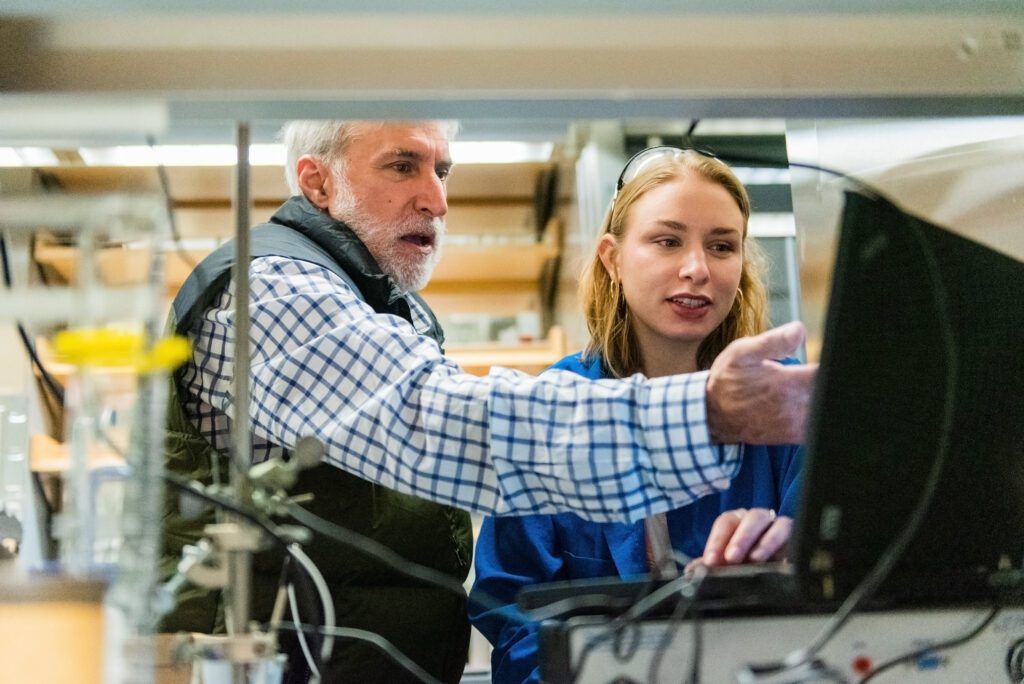“The Sustainocene” – Making Energy and Food with Artificial Photosynthesis
“I like solar energy, but not for the same reason most people like solar. I like solar because it follows everybody around, rich and poor, indiscriminately,” said Daniel Nocera, Patterson Rockwood Professor of Energy at Harvard University.
The chemist behind some of the most innovative developments in green energy and sustainable agriculture expects global energy consumption to double by mid-century. To address this demand without burning more carbon, scientists and policymakers must work together, Nocera asserted at a September 14 research workshop hosted by Harvard University’s Salata Institute for Climate and Sustainability.
“The world has a 18 trillion-watt light bulb on all the time. When the Global South comes online, that becomes 34 trillion watts. If you don’t get the right flavor of energy, there is no way you’re going to have a sustainable planet. It’s impossible,” Nocera said.

The decentralization of energy generation and distribution is key, he believes: For decades his mission has been to give people the power to make their own, clean energy where and when they need it.
Nocera is well known for developing the artificial leaf – a silicon chip coated with water-splitting catalysts that mimic photosynthesis. Using photons from sunlight, the artificial leaf splits water molecules into oxygen and hydrogen – a clean fuel that can be stored and used on-site in fuel cells. Importantly, the leaf can split any water – from the sea, a river, a puddle, even urine. That is useful in large parts of the planet with limited sources of fresh water. And whereas most plants use only 1 percent of the sun’s energy, his artificial leaf is more efficient, using close to 10 percent thanks to a silicon-germanium material that absorbs the full spectrum of the sun’s rays.
Next, Nocera’s team at the Nocera Lab turned that hydrogen into a liquid biofuel, forcing an engineered bacterium – a “bionic leaf” – to combine the hydrogen and ambient carbon dioxide into long-chain hydrocarbons of biomass. This biomass grows 10 times faster than anything in nature, storing sunlight indefinitely in a form that can be used on the spot (no wasteful shipping). Beyond biomass, the bionic leaf has also been engineered to make liquid fuels at efficiencies 100 to 1,000 times the best biofuel processes. Of course, when these fuels are burned they release carbon – but, in this case, not more than the bionic leaf had captured, making this a net-zero fuel. Such technology is seen as critical for hard-to-decarbonize industries like air travel, which contributes about 2.5 percent of global CO2 emissions.
Taking the bionic leaf further, Nocera’s lab found a way to reduce reliance on one of the world’s dirtiest industries: Ammonia fertilizer manufacturing consumes about 2 percent of global energy supply and contributes 5 percent of CO2 emissions.
The lab engineered a cyanobacteria called Xanthobacter autotrophicus to combine hydrogen freshly liberated by the artificial leaf with ambient nitrogen to secrete ammonia. When X. autotrophicus is sprayed on a plant, it attaches itself to the roots, creating ammonia right where it is needed.
Consider the savings from one small farm in California’s Central Valley, where Nocera is experimenting with X. autotrophicus on a 400-acre lettuce crop. In soil enhanced by the bacteria, the crop needed 90 percent less nitrogen fertilizer. That saved 280,000 pounds of CO2 from being emitted during the fertilizer manufacturing process. And the living biofertilizer captured and stored over 57,000 pounds of CO2 in the soil. This represents, according to Nocera, a total savings of 337,000 pounds of CO2 (equal to 174 round-trip bus rides from New York to Los Angeles).
A company Nocera founded, Kula Bio, is currently running 15 field trials of this chemical-free fertilizer across the U.S., from California to Florida.
He hopes these developments together precipitate a “Sustainocene”: a sustainable world with decentralized sources of renewable energy available to all of humanity, not just the rich. But, while his inventions are relatively inexpensive, he is realistic about challenges to widespread adoption. Nocera acknowledges that the world’s leading economies are still primed to dig coal and pump oil, releasing ancient forms of carbon that have been in deep storage for millions of years.
“Don’t listen to any scientist who tells you he invented something to supplant trillions of paid-off dollars of infrastructure,” Nocera said, insisting that a sustainable energy revolution requires scientists to collaborate with policymakers, economists, and business leaders.
To underscore his point for the scientists in the room, he rendered this real-world challenge into a formula: The energy transition is the product of social science, economic policy, and scientific innovation.
That kind of solutions-oriented, interdisciplinary collaboration is embodied at Harvard in the Salata Institute climate research clusters and other initiatives.
